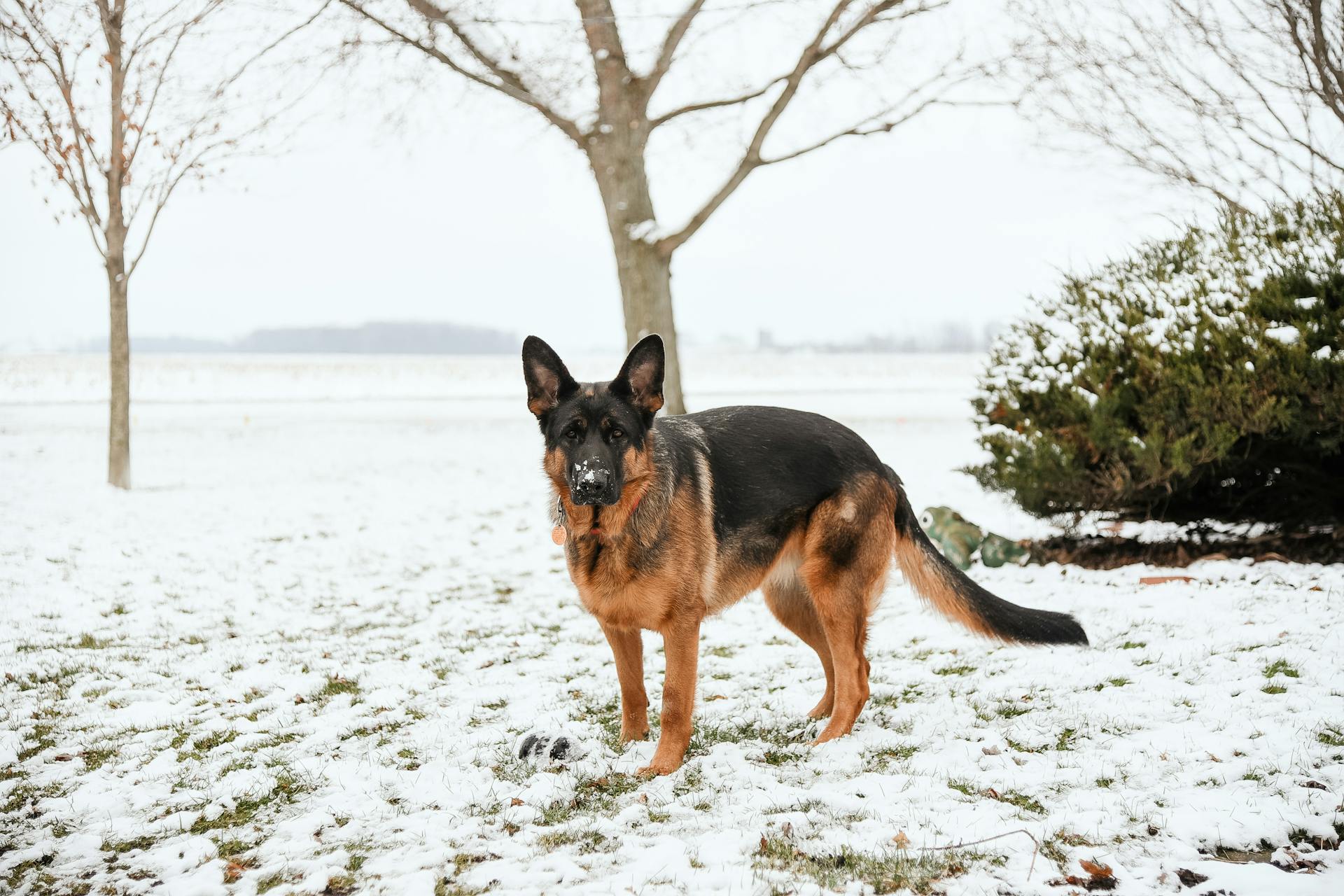
German Shepherds are renowned for their intelligence, and it's no surprise that they excel in obedience training. They are highly trainable, which makes them a popular choice as police and military dogs.
Their loyalty is unmatched, forming strong bonds with their families. German Shepherds are naturally protective of their loved ones, but this doesn't mean they're aggressive - they're simply devoted companions.
With proper socialization, German Shepherds can get along well with other pets and children. This is especially true if they're introduced to new environments and people from an early age.
Their high energy levels require regular exercise and mental stimulation to prevent boredom and destructive behavior.
History and Roles
The German Shepherd breed has a rich history that dates back to 1899 in Germany. They were originally bred as herding dogs.
Their intelligence and loyalty made them a popular choice for police and military work. German Shepherds are often used as guide dogs for the blind.
German Shepherds are highly trainable, which is why they excel in roles such as search and rescue. Their strong work ethic and ability to learn quickly make them a valuable asset in many fields.
Their loyalty and protective nature also make them excellent family pets.
General Information
German Shepherds are a popular breed of dog known for their intelligence and loyalty. They are often used as police and military dogs due to their high trainability.
On average, a German Shepherd can live for 9-13 years. This is a relatively long lifespan compared to other breeds of dogs.
German Shepherds require regular exercise to stay healthy and happy. A daily walk and some playtime should be enough to keep them satisfied.
They typically weigh between 75-95 pounds and stand between 24-26 inches tall at the shoulder. This makes them a medium to large-sized breed of dog.
German Shepherds are highly social animals and thrive on interaction with their human family members. They can become destructive if left alone for too long without proper exercise and attention.
Suggestion: King Shepherd Dog Breed Profile
Care and Upkeep
German Shepherds are high-energy dogs that require regular exercise to stay happy and healthy. They especially enjoy activities that challenge both their bodies and minds, such as agility and tracking.
A daily walk is a must, but it's not enough to keep them satisfied. They love to run, jump, and play, so make sure to provide plenty of opportunities for physical activity.
Fences should be at least 4 feet high, preferably higher, as German Shepherds are skilled jumpers. This will help prevent them from escaping or getting into trouble.
German Shepherds have a thick double coat that sheds heavily, so be prepared for regular grooming. Daily brushing during shedding season is a good idea, but weekly brushing will suffice at other times.
Bathing may need to be more frequent if your German Shepherd is prone to skin problems, which can cause itching, fur loss, and unpleasant odors.
Health and Nutrition
When choosing food for your German Shepherd, look for a high-quality, age-appropriate diet that's labeled puppy, adult, or senior. A large-breed formulation may be a good option.
It's essential to ensure the food is approved by the Association of American Feed Control Officials (AAFCO), which guarantees the ingredients meet established standards. Basic vitamins and mineral supplements are usually not needed if the food is AAFCO-approved.
Avoid giving your German Shepherd table scraps, as they can cause stomach upset and lead to pancreatitis and obesity due to their high fat content.
Joint Dysplasia
Joint dysplasia is a degenerative joint disease that can cause lifelong pain in dogs.
About 20% of German Shepherds have hip dysplasia, which is another type of degenerative joint disease that affects the hind end.
Limping, decreased range of motion, and other signs of pain are common clinical signs of hip dysplasia, especially later in life as arthritis sets in.
The treatment for joint dysplasia includes weight loss, reduced activity, joint supplements, anti-inflammatory and pain medications, or surgery.
Testing like the PennHIP can predict a German Shepherd's risk of developing dysplasia during their lifetime.
What to Feed a Shepherd
When choosing a food for your German Shepherd, it's essential to select a high-quality, age-appropriate diet that meets their nutritional needs. German Shepherds require a large-breed formulation, especially if they're prone to joint issues.
A diet approved by the Association of American Feed Control Officials (AAFCO) is highly recommended, as it ensures the ingredients meet established standards. This means you can trust that your dog's food has the necessary vitamins and minerals.
Avoid giving your German Shepherd table scraps, as they can cause stomach upset and lead to pancreatitis and obesity due to their high fat content. Stick to their regular dog food for optimal health.
Feeding your German Shepherd puppy to adult food typically happens between 12-18 months old, so be sure to discuss this with your veterinarian.
Behavior and Training
Socialization is key to raising a well-adjusted German Shepherd. It's a 7–10 year commitment, after all, and consistent training is a must.
With two German Shepherds, you'll need to double your efforts to keep them engaged and stimulated. Bringing home a German Shepherd puppy requires dedication to daily exercise, which is essential for their physical and mental health.
Their intelligence and high energy levels mean they need near-daily grooming to prevent matting and tangling of their coats.
Beauty and Brains
Horand, the first-ever German Shepherd Dog, was known for his exceptional intelligence and depth of character. He was described by Max Emil Friedrich von Stephanitz as "a gentleman with a boundless zest for living".
Von Stephanitz believed that a dog's working ability was just as important as its appearance. He disagreed with people who wanted the breed to be just a showpiece, and instead focused on creating a dog that was both beautiful and intelligent.
The Thuringian dogs, from which Horand came, tended to be smaller and stockier, often with wiry coats, curled tails, and sharp temperaments. This was in contrast to the Wurttemberg dogs, which were generally larger, heavier-boned, and easier to handle.
Von Stephanitz crossed dogs from Wurttemberg with Thuringian dogs to create a middle ground, resulting in the German Shepherd Dog breed we know today. He believed that this combination would provide a dog that was both strong and agile.
Horand's temperament was stable and well-disposed, making him a great example of the breed's potential. According to von Stephanitz, Horand was "untrained in his puppyhood … [but] nevertheless obedient to the slightest nod when at his master's side".
You might enjoy: Mixed Breeds of Dogs
Behavior and Training
Socialization is key for German Shepherds, so be prepared to introduce your puppy to new people, places, and experiences from an early age. This will help them grow into confident and well-adjusted adult dogs.
Consistent training is a must, as German Shepherds are highly intelligent and need mental stimulation to prevent boredom and destructive behavior. Aim to train your dog daily, using positive reinforcement techniques to encourage good behavior.
Daily exercise is crucial for German Shepherds, as they were bred to be working dogs and need regular physical activity to stay happy and healthy. A minimum of 30 minutes of exercise per day is recommended.
Near-daily grooming is also essential, as German Shepherds have a thick double coat that sheds heavily. Regular brushing will help keep their coat healthy and reduce shedding.
Frequently Asked Questions
How many German Shepherds can live together?
Two well-socialized and trained adult German Shepherds can live together peacefully with proper introduction and care. With the right attention and space, they can thrive as companions.
Featured Images: pexels.com


